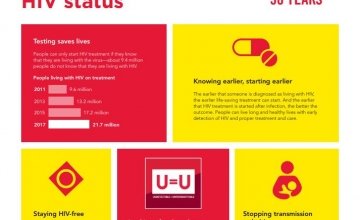
Read our 2022 annual report

Knowledge Hub
What is World AIDS Day and why does it matter?

World AIDS Day (WAD) takes place on 1 December and this year marks 30 years since it began. With over 1.8 million people newly infected with HIV last year alone, Concern’s Global Health & HIV and AIDS Programme Adviser Breda Gahan, explains why the international day of awareness, solidarity and remembrance remains as important as ever.
HIV and AIDS in the 1980s
I first learned of HIV and AIDS when I worked in St. James’s Hospital in the mid 1980’s. It was a very sad time in that everyone infected with HIV died of AIDS during these years. It was not easy being a young person seeing young people die from a new virus in Ireland at the time. I will never forget two young handsome blonde haemophiliac brothers dying from AIDS, infected through ‘Factor VIII’, their treatment for haemophilia imported for the USA back then.
I was working in Sudan with Concern when I first learned of WAD. I was working on a Primary Health Care programme in the Blue Nile Province, and did not know that a day had been dedicated to HIV and AIDS until I later heard about it on the BBC World Service radio.
Is HIV being left behind?
HIV funding has remained flat in recent years at about US$19.1 billion. It is US$7 billion short of the estimated amount needed to achieve the UNAIDS 90-90-90 targets which aims for;
- 90% of all people living with HIV to know their HIV status
- 90% of all people with diagnosed HIV infection to receive sustained antiretroviral therapy
- 90% of all people receiving antiretroviral therapy to have viral suppression by 2020
HIV related stigma and complacency compound slow progress on SDG Target 3.3. – ending AIDS by 2030. The SDG goals are interdependent, and this calls for renewed action.
We all need to counteract a dangerous complacency and address stigma related to HIV and AIDS in all countries, including in Ireland, where there are approximately 10 new HIV diagnoses every week.
Facts about AIDS
- Gender, geography and economic inequality play a significant role in the transmission of HIV.
- Young women are twice as likely to acquire HIV as young men.
- Almost 80% of all people living with HIV live in just twenty countries with South Africa, Nigeria, India and Kenya hosting highest numbers.
- In 2017, there were 36.9 million people living with HIV globally.
- AIDS is the leading cause of death among young people aged 10-24 in Africa, and the second leading cause globally.
- Every week, around 7000 young women aged 15 –24 years become infected with HIV.
Tackling AIDS related stigma
HIV and AIDS responses are integrated into all aspects of Concern programmes. By addressing HIV related stigma and discrimination, we aim to reduce HIV risk and the negative impacts of AIDS on the world’s poorest and most vulnerable people.
Last year, on World AIDS Day, we hosted discussion sessions on HIV transmission and prevention to slum with pavement dwellers in Bangladesh. In Burundi, outreach sessions on HIV and family planning are integrated into the Coaching and Mentoring component of the Graduation programme.
In the Liberia, we host weekly meetings offering communities the platform to discuss issues that affect their well-being, including education on HIV and AIDS prevention. Our Malawi’s Grassroot Soccer work has expanded in 2018 under a new partnership with Save the Children to implement the AMAA (Apatseni Mwayi Atsikana Aphunzire - Let Girl’s Learn) Project.
And in Sudan, we supported the Ministry of Health in Geneina to respond to Malaria and simultaneously raised awareness on HIV and AIDS aimed at both men and women during conversation sessions in the communities in West Darfur.
A lot more to do
Reignited under the new 2018 Primary Health Care Declaration, there are opportunities to enhance linkages for improved HIV and AIDS responses.
I propose that the extreme poor are included among UNAIDS key populationsin an effort towards earlier inclusion for HIV education, prevention, testing and treatment, to sustain lives and livelihoods.
Given that there are around 5,000 new HIV infections a day still globally, it remains important to ‘Know your Risk – Know your Status’ on World AIDS Day and every day.

Breda Gahan is Concern’s Global Health & HIV and AIDS Programme Adviser. She began working in HIV and AIDS as a nurse in St. James’s Hospital, Ireland and has over 30 years’ experience working with Concern overseas.


